MBA Project Report: Strategic Objectives, Team Performance Assessment
VerifiedAdded on 2021/10/10
|17
|4722
|71
Project
AI Summary
This project report, designed for an MBA program, delves into the critical link between strategic objectives and team performance. It explores how businesses can align their goals with team capabilities to achieve a competitive advantage. The report evaluates tools and techniques for setting performance targets, emphasizing the importance of monitoring progress, providing feedback, and utilizing annual performance evaluations. It examines the role of individual commitment, delegation, mentoring, and coaching in achieving objectives. Furthermore, the project assesses various team performance tools and technologies, including the alignment of high-performance drivers and the establishment of clear, measurable objectives. The report also determines the required performance targets and analyzes influencing methodologies and individual dynamics within a team setting. Ultimately, the report aims to provide a comprehensive understanding of how to assess, improve, and sustain team performance to meet organizational goals.
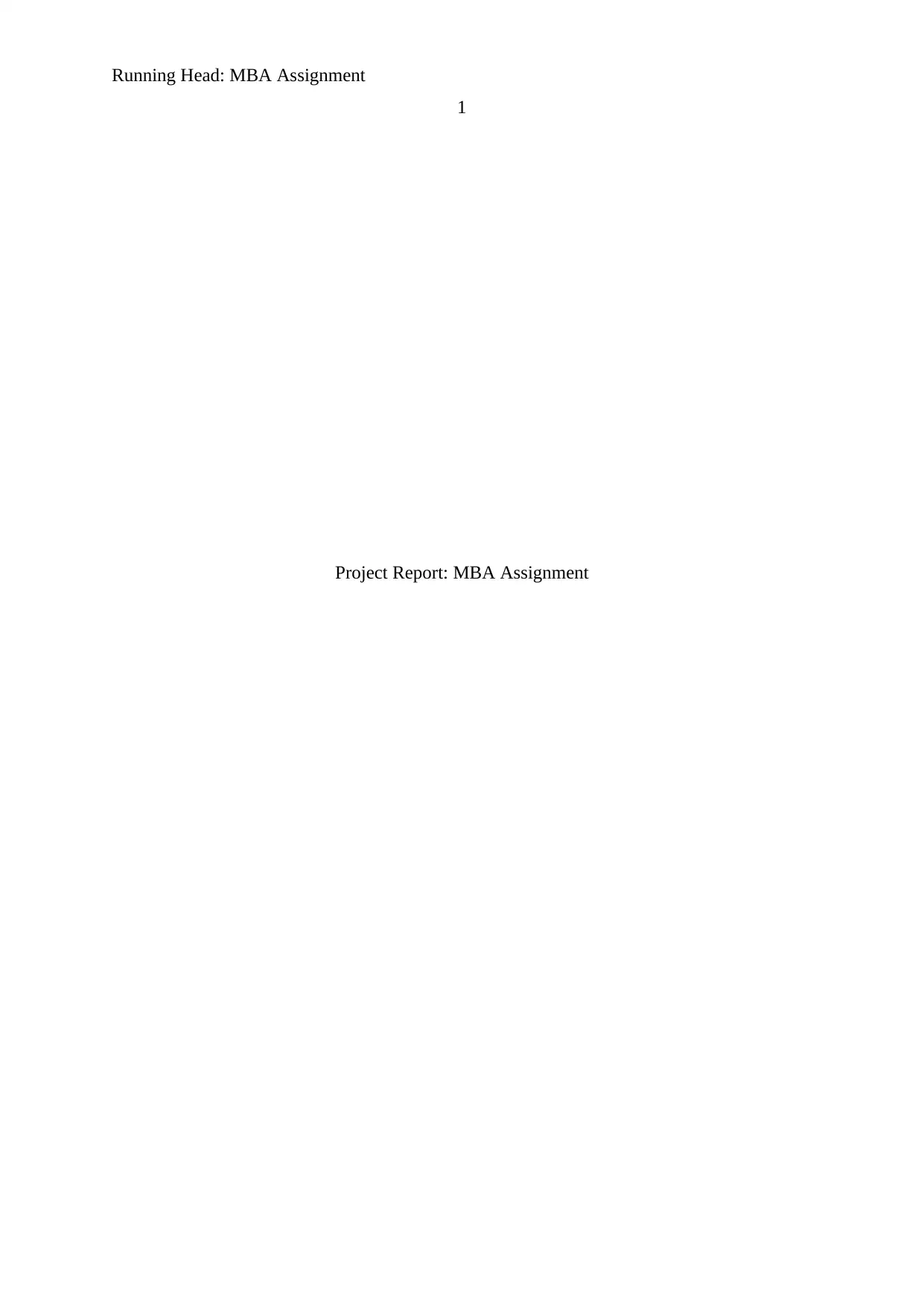
Running Head: MBA Assignment
1
Project Report: MBA Assignment
1
Project Report: MBA Assignment
Paraphrase This Document
Need a fresh take? Get an instant paraphrase of this document with our AI Paraphraser
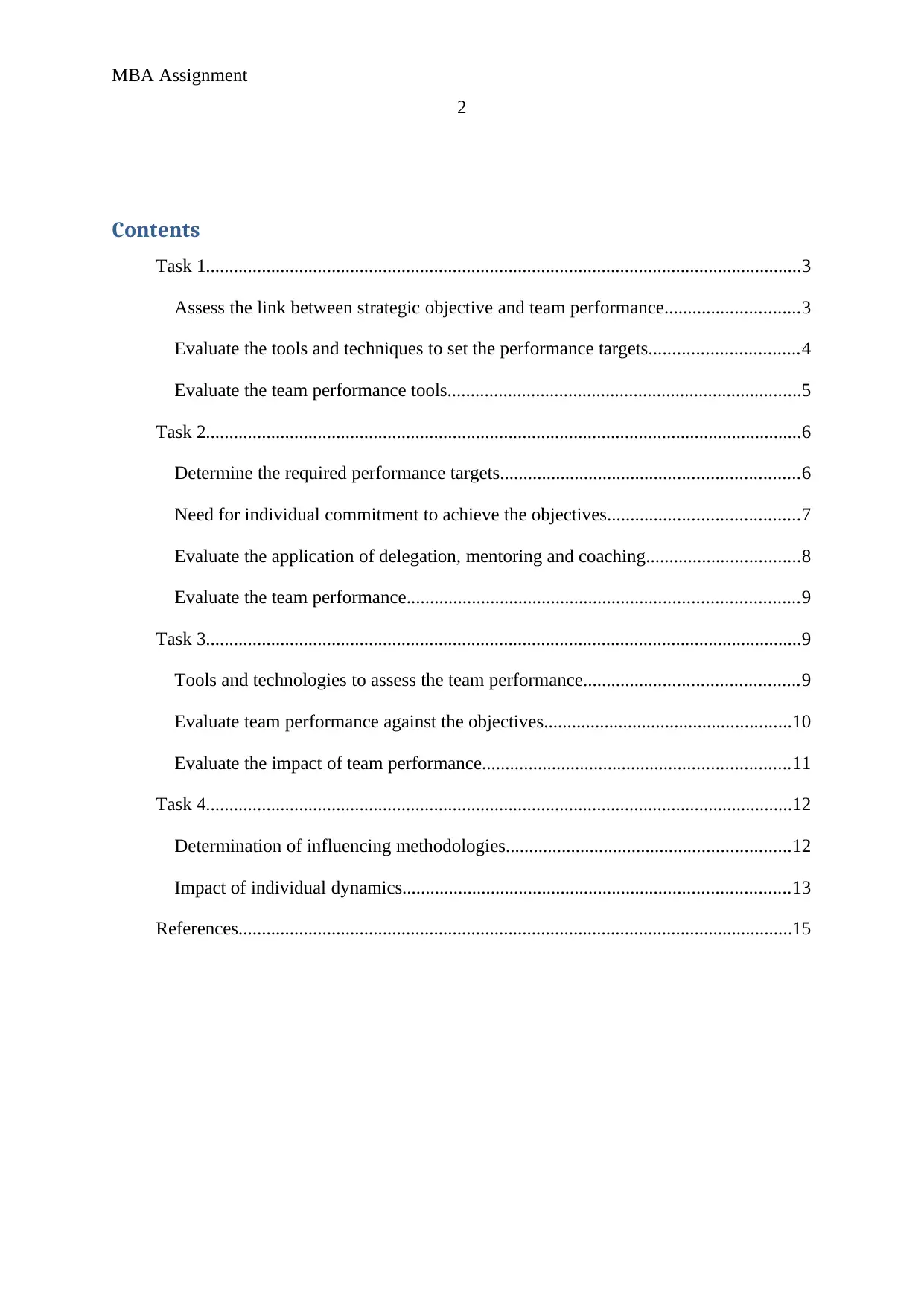
MBA Assignment
2
Contents
Task 1................................................................................................................................3
Assess the link between strategic objective and team performance.............................3
Evaluate the tools and techniques to set the performance targets................................4
Evaluate the team performance tools............................................................................5
Task 2................................................................................................................................6
Determine the required performance targets................................................................6
Need for individual commitment to achieve the objectives.........................................7
Evaluate the application of delegation, mentoring and coaching.................................8
Evaluate the team performance....................................................................................9
Task 3................................................................................................................................9
Tools and technologies to assess the team performance..............................................9
Evaluate team performance against the objectives.....................................................10
Evaluate the impact of team performance..................................................................11
Task 4..............................................................................................................................12
Determination of influencing methodologies.............................................................12
Impact of individual dynamics...................................................................................13
References.......................................................................................................................15
2
Contents
Task 1................................................................................................................................3
Assess the link between strategic objective and team performance.............................3
Evaluate the tools and techniques to set the performance targets................................4
Evaluate the team performance tools............................................................................5
Task 2................................................................................................................................6
Determine the required performance targets................................................................6
Need for individual commitment to achieve the objectives.........................................7
Evaluate the application of delegation, mentoring and coaching.................................8
Evaluate the team performance....................................................................................9
Task 3................................................................................................................................9
Tools and technologies to assess the team performance..............................................9
Evaluate team performance against the objectives.....................................................10
Evaluate the impact of team performance..................................................................11
Task 4..............................................................................................................................12
Determination of influencing methodologies.............................................................12
Impact of individual dynamics...................................................................................13
References.......................................................................................................................15
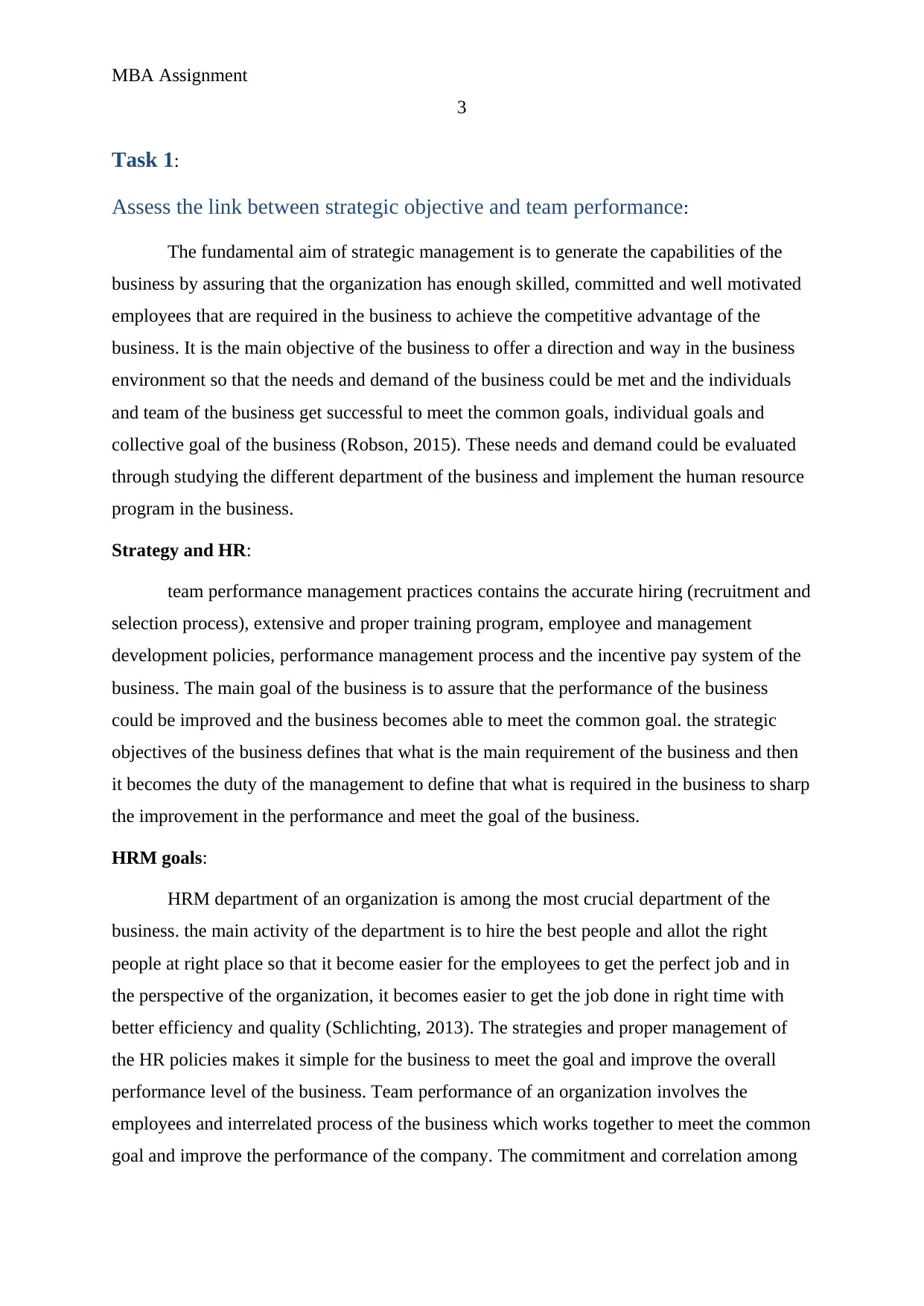
MBA Assignment
3
Task 1:
Assess the link between strategic objective and team performance:
The fundamental aim of strategic management is to generate the capabilities of the
business by assuring that the organization has enough skilled, committed and well motivated
employees that are required in the business to achieve the competitive advantage of the
business. It is the main objective of the business to offer a direction and way in the business
environment so that the needs and demand of the business could be met and the individuals
and team of the business get successful to meet the common goals, individual goals and
collective goal of the business (Robson, 2015). These needs and demand could be evaluated
through studying the different department of the business and implement the human resource
program in the business.
Strategy and HR:
team performance management practices contains the accurate hiring (recruitment and
selection process), extensive and proper training program, employee and management
development policies, performance management process and the incentive pay system of the
business. The main goal of the business is to assure that the performance of the business
could be improved and the business becomes able to meet the common goal. the strategic
objectives of the business defines that what is the main requirement of the business and then
it becomes the duty of the management to define that what is required in the business to sharp
the improvement in the performance and meet the goal of the business.
HRM goals:
HRM department of an organization is among the most crucial department of the
business. the main activity of the department is to hire the best people and allot the right
people at right place so that it become easier for the employees to get the perfect job and in
the perspective of the organization, it becomes easier to get the job done in right time with
better efficiency and quality (Schlichting, 2013). The strategies and proper management of
the HR policies makes it simple for the business to meet the goal and improve the overall
performance level of the business. Team performance of an organization involves the
employees and interrelated process of the business which works together to meet the common
goal and improve the performance of the company. The commitment and correlation among
3
Task 1:
Assess the link between strategic objective and team performance:
The fundamental aim of strategic management is to generate the capabilities of the
business by assuring that the organization has enough skilled, committed and well motivated
employees that are required in the business to achieve the competitive advantage of the
business. It is the main objective of the business to offer a direction and way in the business
environment so that the needs and demand of the business could be met and the individuals
and team of the business get successful to meet the common goals, individual goals and
collective goal of the business (Robson, 2015). These needs and demand could be evaluated
through studying the different department of the business and implement the human resource
program in the business.
Strategy and HR:
team performance management practices contains the accurate hiring (recruitment and
selection process), extensive and proper training program, employee and management
development policies, performance management process and the incentive pay system of the
business. The main goal of the business is to assure that the performance of the business
could be improved and the business becomes able to meet the common goal. the strategic
objectives of the business defines that what is the main requirement of the business and then
it becomes the duty of the management to define that what is required in the business to sharp
the improvement in the performance and meet the goal of the business.
HRM goals:
HRM department of an organization is among the most crucial department of the
business. the main activity of the department is to hire the best people and allot the right
people at right place so that it become easier for the employees to get the perfect job and in
the perspective of the organization, it becomes easier to get the job done in right time with
better efficiency and quality (Schlichting, 2013). The strategies and proper management of
the HR policies makes it simple for the business to meet the goal and improve the overall
performance level of the business. Team performance of an organization involves the
employees and interrelated process of the business which works together to meet the common
goal and improve the performance of the company. The commitment and correlation among
⊘ This is a preview!⊘
Do you want full access?
Subscribe today to unlock all pages.

Trusted by 1+ million students worldwide
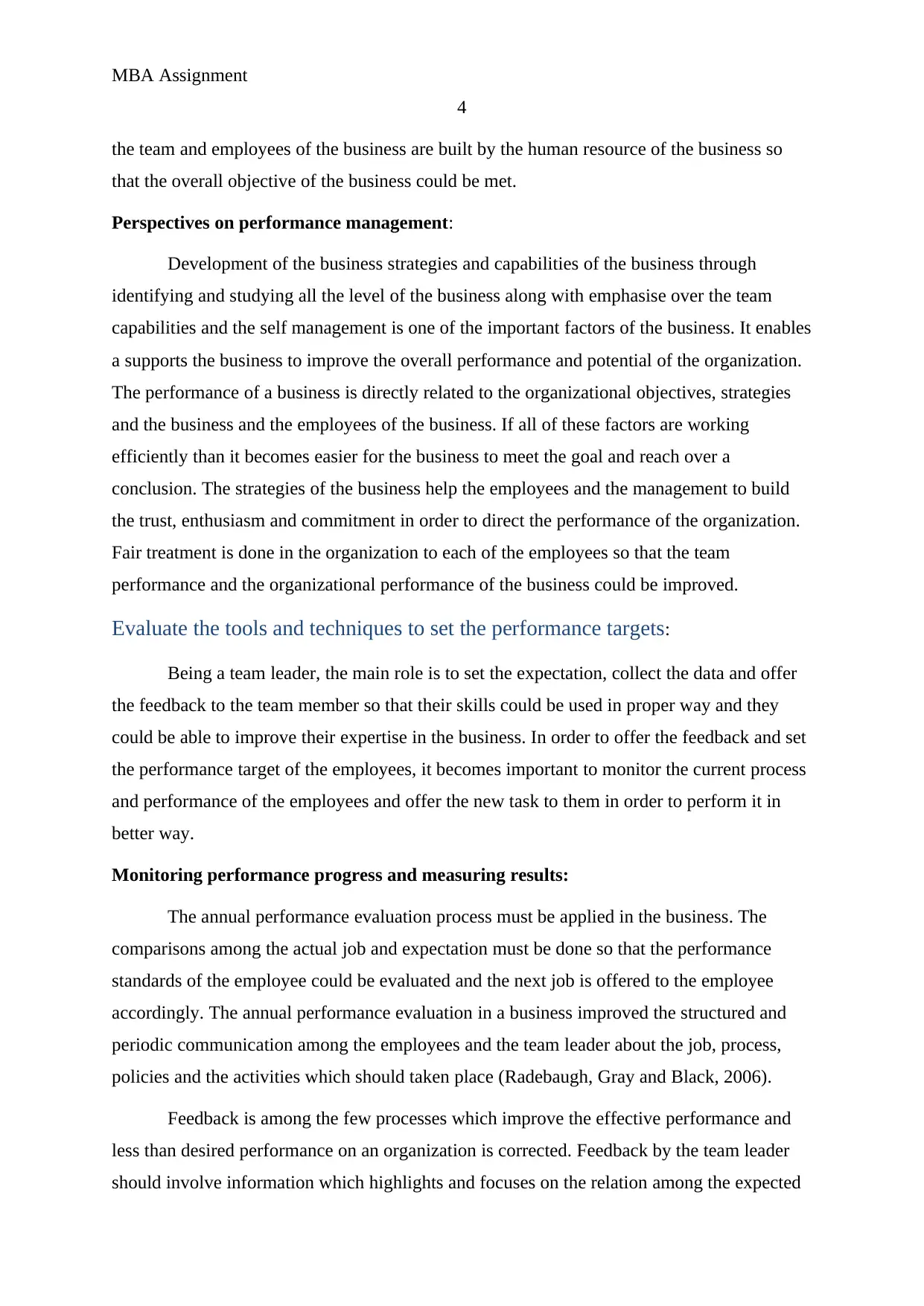
MBA Assignment
4
the team and employees of the business are built by the human resource of the business so
that the overall objective of the business could be met.
Perspectives on performance management:
Development of the business strategies and capabilities of the business through
identifying and studying all the level of the business along with emphasise over the team
capabilities and the self management is one of the important factors of the business. It enables
a supports the business to improve the overall performance and potential of the organization.
The performance of a business is directly related to the organizational objectives, strategies
and the business and the employees of the business. If all of these factors are working
efficiently than it becomes easier for the business to meet the goal and reach over a
conclusion. The strategies of the business help the employees and the management to build
the trust, enthusiasm and commitment in order to direct the performance of the organization.
Fair treatment is done in the organization to each of the employees so that the team
performance and the organizational performance of the business could be improved.
Evaluate the tools and techniques to set the performance targets:
Being a team leader, the main role is to set the expectation, collect the data and offer
the feedback to the team member so that their skills could be used in proper way and they
could be able to improve their expertise in the business. In order to offer the feedback and set
the performance target of the employees, it becomes important to monitor the current process
and performance of the employees and offer the new task to them in order to perform it in
better way.
Monitoring performance progress and measuring results:
The annual performance evaluation process must be applied in the business. The
comparisons among the actual job and expectation must be done so that the performance
standards of the employee could be evaluated and the next job is offered to the employee
accordingly. The annual performance evaluation in a business improved the structured and
periodic communication among the employees and the team leader about the job, process,
policies and the activities which should taken place (Radebaugh, Gray and Black, 2006).
Feedback is among the few processes which improve the effective performance and
less than desired performance on an organization is corrected. Feedback by the team leader
should involve information which highlights and focuses on the relation among the expected
4
the team and employees of the business are built by the human resource of the business so
that the overall objective of the business could be met.
Perspectives on performance management:
Development of the business strategies and capabilities of the business through
identifying and studying all the level of the business along with emphasise over the team
capabilities and the self management is one of the important factors of the business. It enables
a supports the business to improve the overall performance and potential of the organization.
The performance of a business is directly related to the organizational objectives, strategies
and the business and the employees of the business. If all of these factors are working
efficiently than it becomes easier for the business to meet the goal and reach over a
conclusion. The strategies of the business help the employees and the management to build
the trust, enthusiasm and commitment in order to direct the performance of the organization.
Fair treatment is done in the organization to each of the employees so that the team
performance and the organizational performance of the business could be improved.
Evaluate the tools and techniques to set the performance targets:
Being a team leader, the main role is to set the expectation, collect the data and offer
the feedback to the team member so that their skills could be used in proper way and they
could be able to improve their expertise in the business. In order to offer the feedback and set
the performance target of the employees, it becomes important to monitor the current process
and performance of the employees and offer the new task to them in order to perform it in
better way.
Monitoring performance progress and measuring results:
The annual performance evaluation process must be applied in the business. The
comparisons among the actual job and expectation must be done so that the performance
standards of the employee could be evaluated and the next job is offered to the employee
accordingly. The annual performance evaluation in a business improved the structured and
periodic communication among the employees and the team leader about the job, process,
policies and the activities which should taken place (Radebaugh, Gray and Black, 2006).
Feedback is among the few processes which improve the effective performance and
less than desired performance on an organization is corrected. Feedback by the team leader
should involve information which highlights and focuses on the relation among the expected
Paraphrase This Document
Need a fresh take? Get an instant paraphrase of this document with our AI Paraphraser
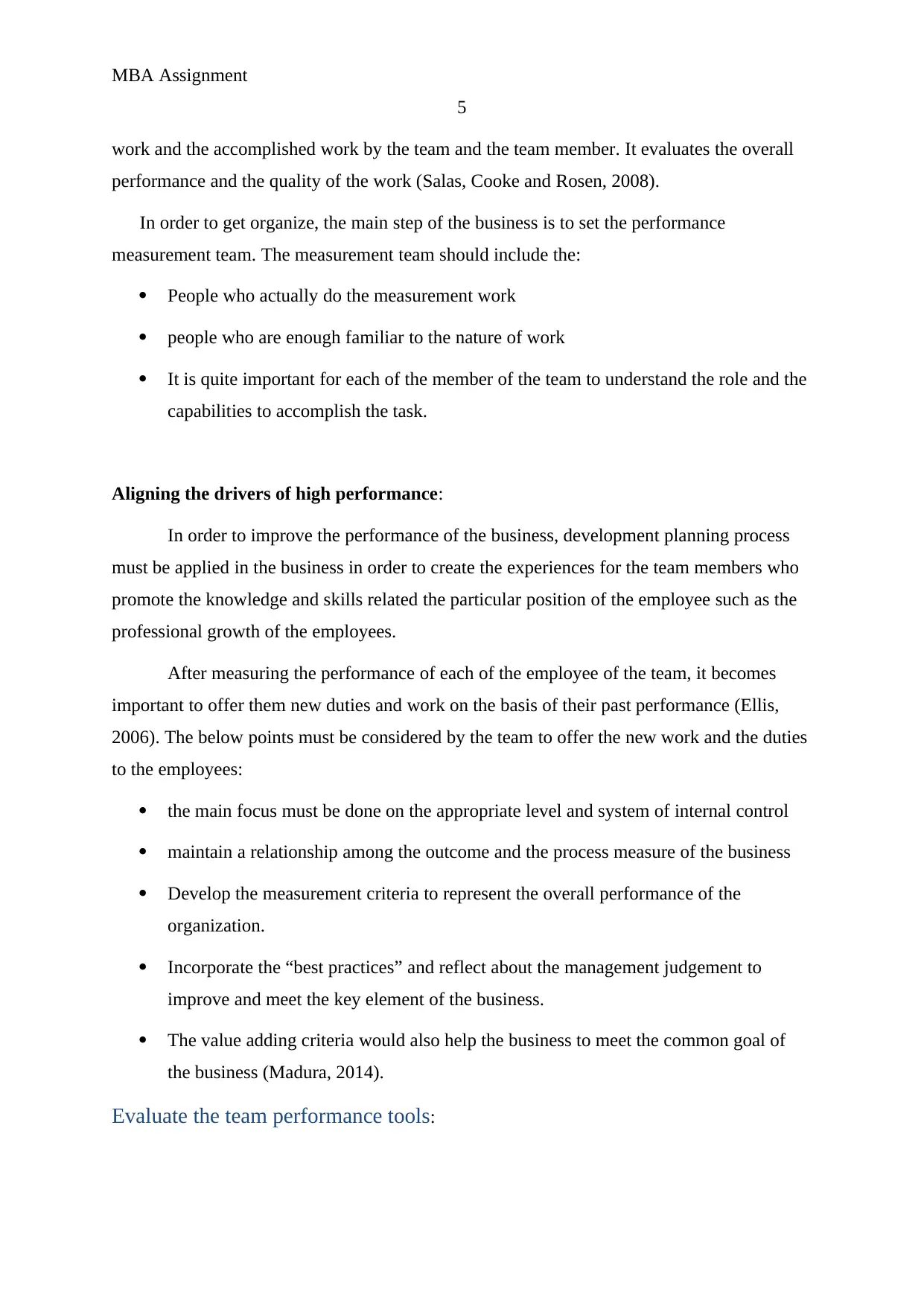
MBA Assignment
5
work and the accomplished work by the team and the team member. It evaluates the overall
performance and the quality of the work (Salas, Cooke and Rosen, 2008).
In order to get organize, the main step of the business is to set the performance
measurement team. The measurement team should include the:
People who actually do the measurement work
people who are enough familiar to the nature of work
It is quite important for each of the member of the team to understand the role and the
capabilities to accomplish the task.
Aligning the drivers of high performance:
In order to improve the performance of the business, development planning process
must be applied in the business in order to create the experiences for the team members who
promote the knowledge and skills related the particular position of the employee such as the
professional growth of the employees.
After measuring the performance of each of the employee of the team, it becomes
important to offer them new duties and work on the basis of their past performance (Ellis,
2006). The below points must be considered by the team to offer the new work and the duties
to the employees:
the main focus must be done on the appropriate level and system of internal control
maintain a relationship among the outcome and the process measure of the business
Develop the measurement criteria to represent the overall performance of the
organization.
Incorporate the “best practices” and reflect about the management judgement to
improve and meet the key element of the business.
The value adding criteria would also help the business to meet the common goal of
the business (Madura, 2014).
Evaluate the team performance tools:
5
work and the accomplished work by the team and the team member. It evaluates the overall
performance and the quality of the work (Salas, Cooke and Rosen, 2008).
In order to get organize, the main step of the business is to set the performance
measurement team. The measurement team should include the:
People who actually do the measurement work
people who are enough familiar to the nature of work
It is quite important for each of the member of the team to understand the role and the
capabilities to accomplish the task.
Aligning the drivers of high performance:
In order to improve the performance of the business, development planning process
must be applied in the business in order to create the experiences for the team members who
promote the knowledge and skills related the particular position of the employee such as the
professional growth of the employees.
After measuring the performance of each of the employee of the team, it becomes
important to offer them new duties and work on the basis of their past performance (Ellis,
2006). The below points must be considered by the team to offer the new work and the duties
to the employees:
the main focus must be done on the appropriate level and system of internal control
maintain a relationship among the outcome and the process measure of the business
Develop the measurement criteria to represent the overall performance of the
organization.
Incorporate the “best practices” and reflect about the management judgement to
improve and meet the key element of the business.
The value adding criteria would also help the business to meet the common goal of
the business (Madura, 2014).
Evaluate the team performance tools:
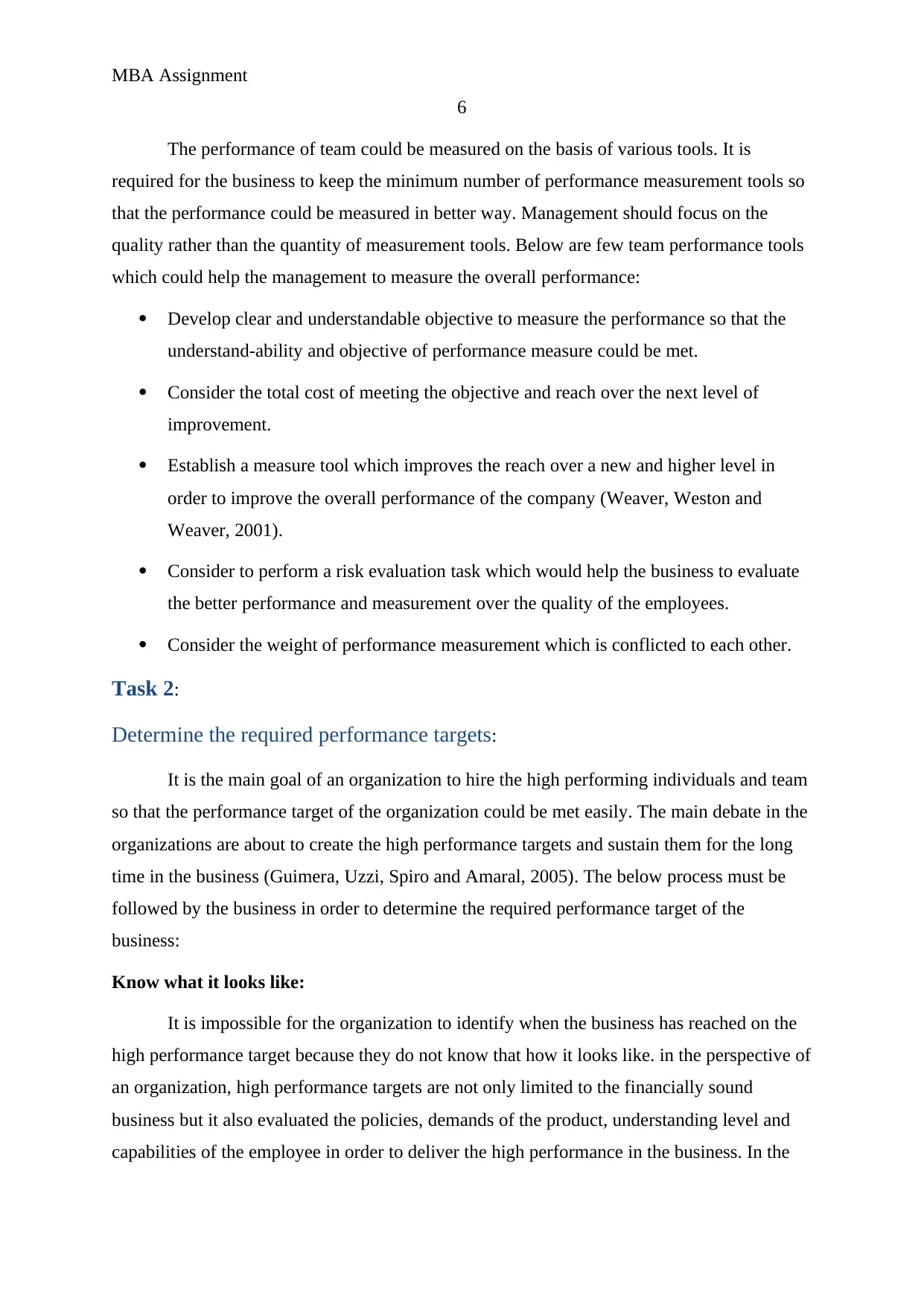
MBA Assignment
6
The performance of team could be measured on the basis of various tools. It is
required for the business to keep the minimum number of performance measurement tools so
that the performance could be measured in better way. Management should focus on the
quality rather than the quantity of measurement tools. Below are few team performance tools
which could help the management to measure the overall performance:
Develop clear and understandable objective to measure the performance so that the
understand-ability and objective of performance measure could be met.
Consider the total cost of meeting the objective and reach over the next level of
improvement.
Establish a measure tool which improves the reach over a new and higher level in
order to improve the overall performance of the company (Weaver, Weston and
Weaver, 2001).
Consider to perform a risk evaluation task which would help the business to evaluate
the better performance and measurement over the quality of the employees.
Consider the weight of performance measurement which is conflicted to each other.
Task 2:
Determine the required performance targets:
It is the main goal of an organization to hire the high performing individuals and team
so that the performance target of the organization could be met easily. The main debate in the
organizations are about to create the high performance targets and sustain them for the long
time in the business (Guimera, Uzzi, Spiro and Amaral, 2005). The below process must be
followed by the business in order to determine the required performance target of the
business:
Know what it looks like:
It is impossible for the organization to identify when the business has reached on the
high performance target because they do not know that how it looks like. in the perspective of
an organization, high performance targets are not only limited to the financially sound
business but it also evaluated the policies, demands of the product, understanding level and
capabilities of the employee in order to deliver the high performance in the business. In the
6
The performance of team could be measured on the basis of various tools. It is
required for the business to keep the minimum number of performance measurement tools so
that the performance could be measured in better way. Management should focus on the
quality rather than the quantity of measurement tools. Below are few team performance tools
which could help the management to measure the overall performance:
Develop clear and understandable objective to measure the performance so that the
understand-ability and objective of performance measure could be met.
Consider the total cost of meeting the objective and reach over the next level of
improvement.
Establish a measure tool which improves the reach over a new and higher level in
order to improve the overall performance of the company (Weaver, Weston and
Weaver, 2001).
Consider to perform a risk evaluation task which would help the business to evaluate
the better performance and measurement over the quality of the employees.
Consider the weight of performance measurement which is conflicted to each other.
Task 2:
Determine the required performance targets:
It is the main goal of an organization to hire the high performing individuals and team
so that the performance target of the organization could be met easily. The main debate in the
organizations are about to create the high performance targets and sustain them for the long
time in the business (Guimera, Uzzi, Spiro and Amaral, 2005). The below process must be
followed by the business in order to determine the required performance target of the
business:
Know what it looks like:
It is impossible for the organization to identify when the business has reached on the
high performance target because they do not know that how it looks like. in the perspective of
an organization, high performance targets are not only limited to the financially sound
business but it also evaluated the policies, demands of the product, understanding level and
capabilities of the employee in order to deliver the high performance in the business. In the
⊘ This is a preview!⊘
Do you want full access?
Subscribe today to unlock all pages.

Trusted by 1+ million students worldwide
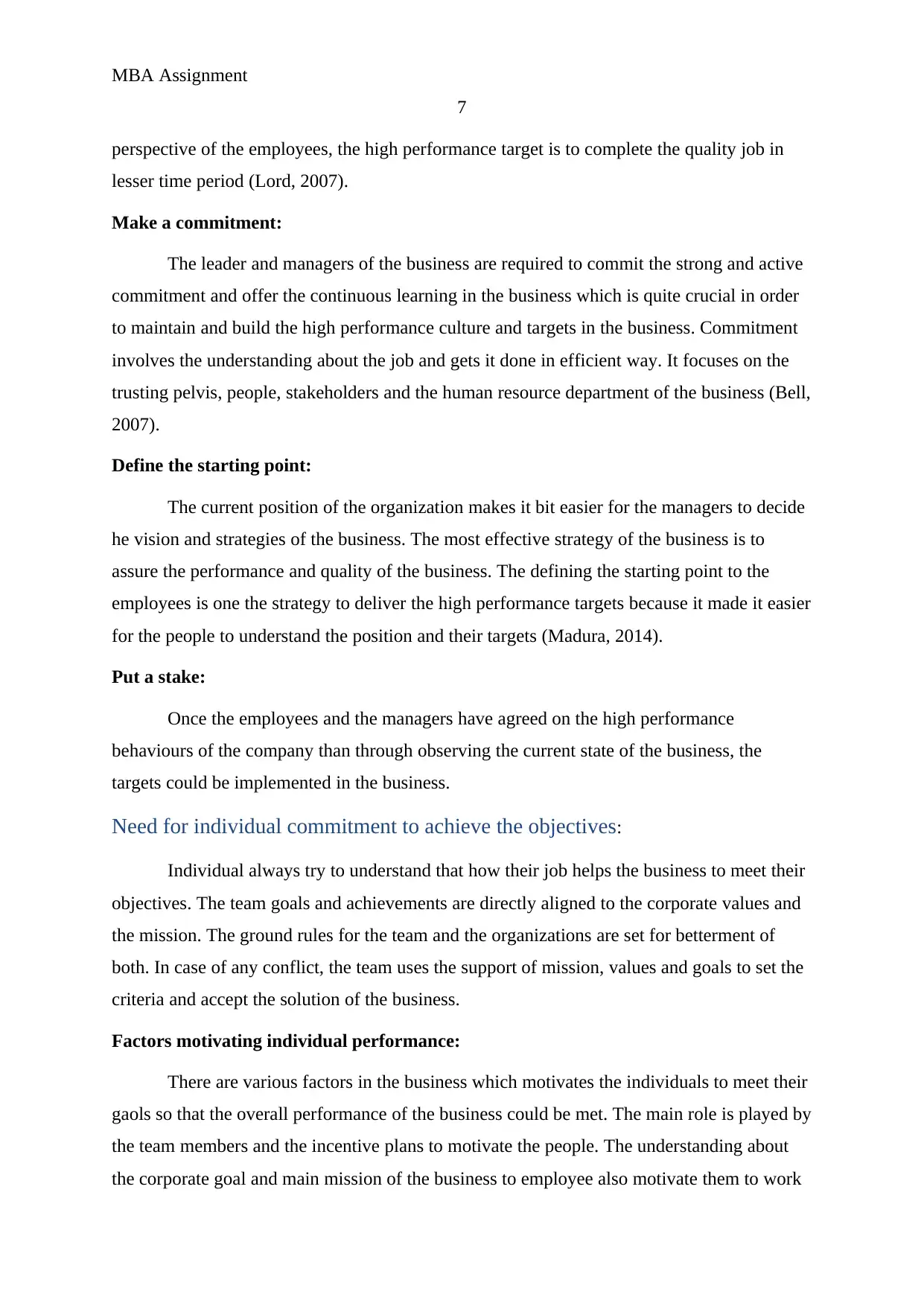
MBA Assignment
7
perspective of the employees, the high performance target is to complete the quality job in
lesser time period (Lord, 2007).
Make a commitment:
The leader and managers of the business are required to commit the strong and active
commitment and offer the continuous learning in the business which is quite crucial in order
to maintain and build the high performance culture and targets in the business. Commitment
involves the understanding about the job and gets it done in efficient way. It focuses on the
trusting pelvis, people, stakeholders and the human resource department of the business (Bell,
2007).
Define the starting point:
The current position of the organization makes it bit easier for the managers to decide
he vision and strategies of the business. The most effective strategy of the business is to
assure the performance and quality of the business. The defining the starting point to the
employees is one the strategy to deliver the high performance targets because it made it easier
for the people to understand the position and their targets (Madura, 2014).
Put a stake:
Once the employees and the managers have agreed on the high performance
behaviours of the company than through observing the current state of the business, the
targets could be implemented in the business.
Need for individual commitment to achieve the objectives:
Individual always try to understand that how their job helps the business to meet their
objectives. The team goals and achievements are directly aligned to the corporate values and
the mission. The ground rules for the team and the organizations are set for betterment of
both. In case of any conflict, the team uses the support of mission, values and goals to set the
criteria and accept the solution of the business.
Factors motivating individual performance:
There are various factors in the business which motivates the individuals to meet their
gaols so that the overall performance of the business could be met. The main role is played by
the team members and the incentive plans to motivate the people. The understanding about
the corporate goal and main mission of the business to employee also motivate them to work
7
perspective of the employees, the high performance target is to complete the quality job in
lesser time period (Lord, 2007).
Make a commitment:
The leader and managers of the business are required to commit the strong and active
commitment and offer the continuous learning in the business which is quite crucial in order
to maintain and build the high performance culture and targets in the business. Commitment
involves the understanding about the job and gets it done in efficient way. It focuses on the
trusting pelvis, people, stakeholders and the human resource department of the business (Bell,
2007).
Define the starting point:
The current position of the organization makes it bit easier for the managers to decide
he vision and strategies of the business. The most effective strategy of the business is to
assure the performance and quality of the business. The defining the starting point to the
employees is one the strategy to deliver the high performance targets because it made it easier
for the people to understand the position and their targets (Madura, 2014).
Put a stake:
Once the employees and the managers have agreed on the high performance
behaviours of the company than through observing the current state of the business, the
targets could be implemented in the business.
Need for individual commitment to achieve the objectives:
Individual always try to understand that how their job helps the business to meet their
objectives. The team goals and achievements are directly aligned to the corporate values and
the mission. The ground rules for the team and the organizations are set for betterment of
both. In case of any conflict, the team uses the support of mission, values and goals to set the
criteria and accept the solution of the business.
Factors motivating individual performance:
There are various factors in the business which motivates the individuals to meet their
gaols so that the overall performance of the business could be met. The main role is played by
the team members and the incentive plans to motivate the people. The understanding about
the corporate goal and main mission of the business to employee also motivate them to work
Paraphrase This Document
Need a fresh take? Get an instant paraphrase of this document with our AI Paraphraser
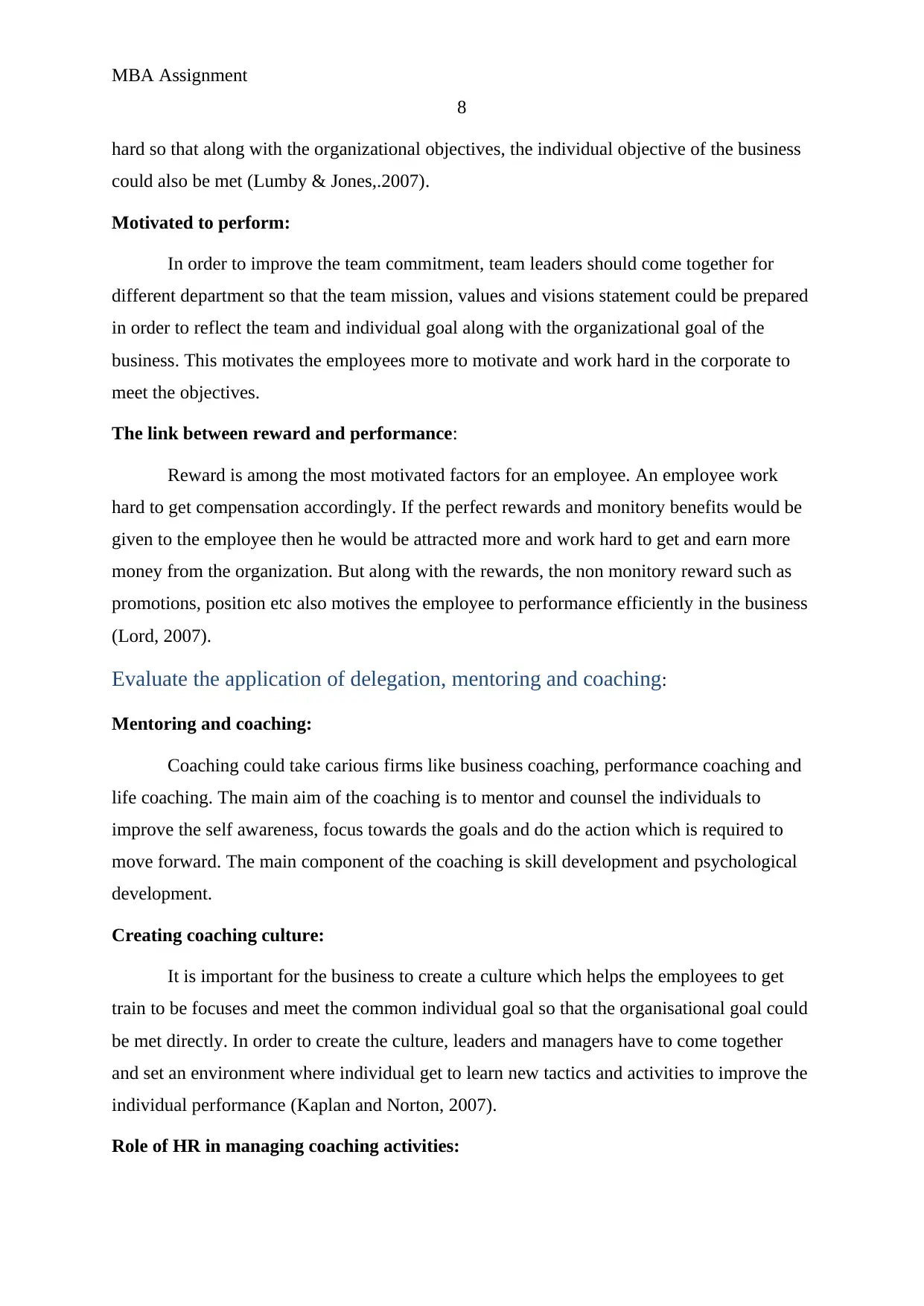
MBA Assignment
8
hard so that along with the organizational objectives, the individual objective of the business
could also be met (Lumby & Jones,.2007).
Motivated to perform:
In order to improve the team commitment, team leaders should come together for
different department so that the team mission, values and visions statement could be prepared
in order to reflect the team and individual goal along with the organizational goal of the
business. This motivates the employees more to motivate and work hard in the corporate to
meet the objectives.
The link between reward and performance:
Reward is among the most motivated factors for an employee. An employee work
hard to get compensation accordingly. If the perfect rewards and monitory benefits would be
given to the employee then he would be attracted more and work hard to get and earn more
money from the organization. But along with the rewards, the non monitory reward such as
promotions, position etc also motives the employee to performance efficiently in the business
(Lord, 2007).
Evaluate the application of delegation, mentoring and coaching:
Mentoring and coaching:
Coaching could take carious firms like business coaching, performance coaching and
life coaching. The main aim of the coaching is to mentor and counsel the individuals to
improve the self awareness, focus towards the goals and do the action which is required to
move forward. The main component of the coaching is skill development and psychological
development.
Creating coaching culture:
It is important for the business to create a culture which helps the employees to get
train to be focuses and meet the common individual goal so that the organisational goal could
be met directly. In order to create the culture, leaders and managers have to come together
and set an environment where individual get to learn new tactics and activities to improve the
individual performance (Kaplan and Norton, 2007).
Role of HR in managing coaching activities:
8
hard so that along with the organizational objectives, the individual objective of the business
could also be met (Lumby & Jones,.2007).
Motivated to perform:
In order to improve the team commitment, team leaders should come together for
different department so that the team mission, values and visions statement could be prepared
in order to reflect the team and individual goal along with the organizational goal of the
business. This motivates the employees more to motivate and work hard in the corporate to
meet the objectives.
The link between reward and performance:
Reward is among the most motivated factors for an employee. An employee work
hard to get compensation accordingly. If the perfect rewards and monitory benefits would be
given to the employee then he would be attracted more and work hard to get and earn more
money from the organization. But along with the rewards, the non monitory reward such as
promotions, position etc also motives the employee to performance efficiently in the business
(Lord, 2007).
Evaluate the application of delegation, mentoring and coaching:
Mentoring and coaching:
Coaching could take carious firms like business coaching, performance coaching and
life coaching. The main aim of the coaching is to mentor and counsel the individuals to
improve the self awareness, focus towards the goals and do the action which is required to
move forward. The main component of the coaching is skill development and psychological
development.
Creating coaching culture:
It is important for the business to create a culture which helps the employees to get
train to be focuses and meet the common individual goal so that the organisational goal could
be met directly. In order to create the culture, leaders and managers have to come together
and set an environment where individual get to learn new tactics and activities to improve the
individual performance (Kaplan and Norton, 2007).
Role of HR in managing coaching activities:
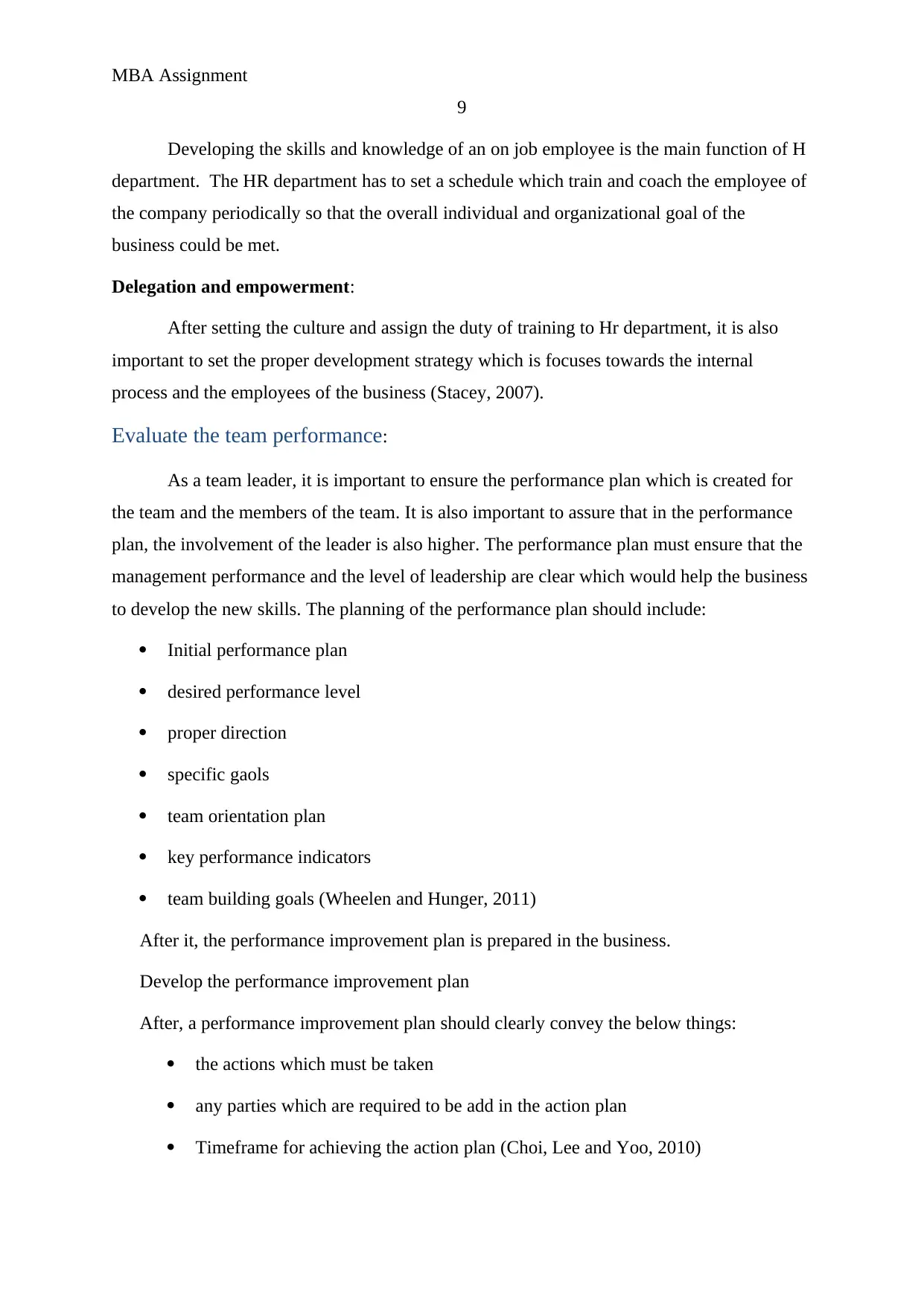
MBA Assignment
9
Developing the skills and knowledge of an on job employee is the main function of H
department. The HR department has to set a schedule which train and coach the employee of
the company periodically so that the overall individual and organizational goal of the
business could be met.
Delegation and empowerment:
After setting the culture and assign the duty of training to Hr department, it is also
important to set the proper development strategy which is focuses towards the internal
process and the employees of the business (Stacey, 2007).
Evaluate the team performance:
As a team leader, it is important to ensure the performance plan which is created for
the team and the members of the team. It is also important to assure that in the performance
plan, the involvement of the leader is also higher. The performance plan must ensure that the
management performance and the level of leadership are clear which would help the business
to develop the new skills. The planning of the performance plan should include:
Initial performance plan
desired performance level
proper direction
specific gaols
team orientation plan
key performance indicators
team building goals (Wheelen and Hunger, 2011)
After it, the performance improvement plan is prepared in the business.
Develop the performance improvement plan
After, a performance improvement plan should clearly convey the below things:
the actions which must be taken
any parties which are required to be add in the action plan
Timeframe for achieving the action plan (Choi, Lee and Yoo, 2010)
9
Developing the skills and knowledge of an on job employee is the main function of H
department. The HR department has to set a schedule which train and coach the employee of
the company periodically so that the overall individual and organizational goal of the
business could be met.
Delegation and empowerment:
After setting the culture and assign the duty of training to Hr department, it is also
important to set the proper development strategy which is focuses towards the internal
process and the employees of the business (Stacey, 2007).
Evaluate the team performance:
As a team leader, it is important to ensure the performance plan which is created for
the team and the members of the team. It is also important to assure that in the performance
plan, the involvement of the leader is also higher. The performance plan must ensure that the
management performance and the level of leadership are clear which would help the business
to develop the new skills. The planning of the performance plan should include:
Initial performance plan
desired performance level
proper direction
specific gaols
team orientation plan
key performance indicators
team building goals (Wheelen and Hunger, 2011)
After it, the performance improvement plan is prepared in the business.
Develop the performance improvement plan
After, a performance improvement plan should clearly convey the below things:
the actions which must be taken
any parties which are required to be add in the action plan
Timeframe for achieving the action plan (Choi, Lee and Yoo, 2010)
⊘ This is a preview!⊘
Do you want full access?
Subscribe today to unlock all pages.

Trusted by 1+ million students worldwide
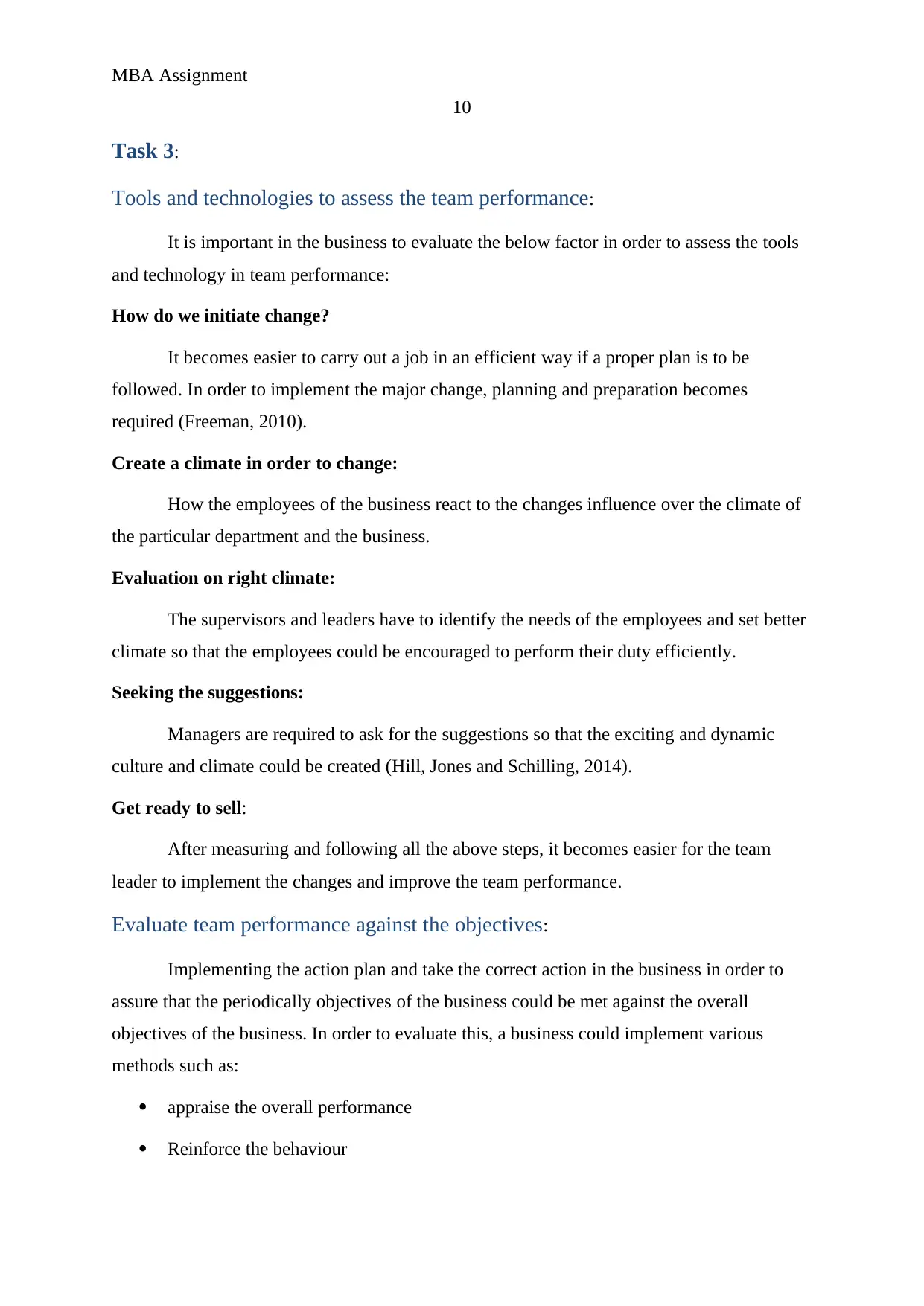
MBA Assignment
10
Task 3:
Tools and technologies to assess the team performance:
It is important in the business to evaluate the below factor in order to assess the tools
and technology in team performance:
How do we initiate change?
It becomes easier to carry out a job in an efficient way if a proper plan is to be
followed. In order to implement the major change, planning and preparation becomes
required (Freeman, 2010).
Create a climate in order to change:
How the employees of the business react to the changes influence over the climate of
the particular department and the business.
Evaluation on right climate:
The supervisors and leaders have to identify the needs of the employees and set better
climate so that the employees could be encouraged to perform their duty efficiently.
Seeking the suggestions:
Managers are required to ask for the suggestions so that the exciting and dynamic
culture and climate could be created (Hill, Jones and Schilling, 2014).
Get ready to sell:
After measuring and following all the above steps, it becomes easier for the team
leader to implement the changes and improve the team performance.
Evaluate team performance against the objectives:
Implementing the action plan and take the correct action in the business in order to
assure that the periodically objectives of the business could be met against the overall
objectives of the business. In order to evaluate this, a business could implement various
methods such as:
appraise the overall performance
Reinforce the behaviour
10
Task 3:
Tools and technologies to assess the team performance:
It is important in the business to evaluate the below factor in order to assess the tools
and technology in team performance:
How do we initiate change?
It becomes easier to carry out a job in an efficient way if a proper plan is to be
followed. In order to implement the major change, planning and preparation becomes
required (Freeman, 2010).
Create a climate in order to change:
How the employees of the business react to the changes influence over the climate of
the particular department and the business.
Evaluation on right climate:
The supervisors and leaders have to identify the needs of the employees and set better
climate so that the employees could be encouraged to perform their duty efficiently.
Seeking the suggestions:
Managers are required to ask for the suggestions so that the exciting and dynamic
culture and climate could be created (Hill, Jones and Schilling, 2014).
Get ready to sell:
After measuring and following all the above steps, it becomes easier for the team
leader to implement the changes and improve the team performance.
Evaluate team performance against the objectives:
Implementing the action plan and take the correct action in the business in order to
assure that the periodically objectives of the business could be met against the overall
objectives of the business. In order to evaluate this, a business could implement various
methods such as:
appraise the overall performance
Reinforce the behaviour
Paraphrase This Document
Need a fresh take? Get an instant paraphrase of this document with our AI Paraphraser
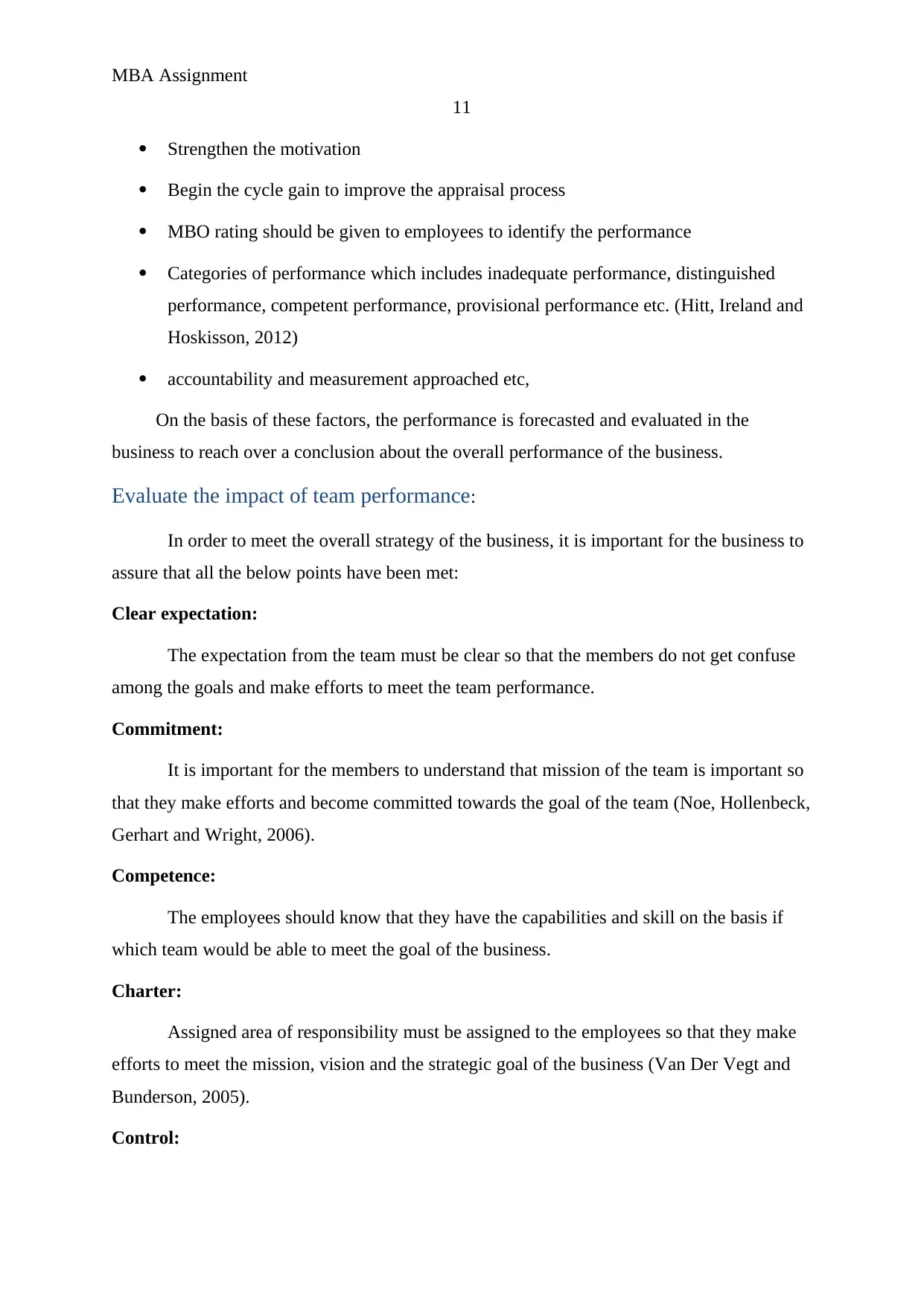
MBA Assignment
11
Strengthen the motivation
Begin the cycle gain to improve the appraisal process
MBO rating should be given to employees to identify the performance
Categories of performance which includes inadequate performance, distinguished
performance, competent performance, provisional performance etc. (Hitt, Ireland and
Hoskisson, 2012)
accountability and measurement approached etc,
On the basis of these factors, the performance is forecasted and evaluated in the
business to reach over a conclusion about the overall performance of the business.
Evaluate the impact of team performance:
In order to meet the overall strategy of the business, it is important for the business to
assure that all the below points have been met:
Clear expectation:
The expectation from the team must be clear so that the members do not get confuse
among the goals and make efforts to meet the team performance.
Commitment:
It is important for the members to understand that mission of the team is important so
that they make efforts and become committed towards the goal of the team (Noe, Hollenbeck,
Gerhart and Wright, 2006).
Competence:
The employees should know that they have the capabilities and skill on the basis if
which team would be able to meet the goal of the business.
Charter:
Assigned area of responsibility must be assigned to the employees so that they make
efforts to meet the mission, vision and the strategic goal of the business (Van Der Vegt and
Bunderson, 2005).
Control:
11
Strengthen the motivation
Begin the cycle gain to improve the appraisal process
MBO rating should be given to employees to identify the performance
Categories of performance which includes inadequate performance, distinguished
performance, competent performance, provisional performance etc. (Hitt, Ireland and
Hoskisson, 2012)
accountability and measurement approached etc,
On the basis of these factors, the performance is forecasted and evaluated in the
business to reach over a conclusion about the overall performance of the business.
Evaluate the impact of team performance:
In order to meet the overall strategy of the business, it is important for the business to
assure that all the below points have been met:
Clear expectation:
The expectation from the team must be clear so that the members do not get confuse
among the goals and make efforts to meet the team performance.
Commitment:
It is important for the members to understand that mission of the team is important so
that they make efforts and become committed towards the goal of the team (Noe, Hollenbeck,
Gerhart and Wright, 2006).
Competence:
The employees should know that they have the capabilities and skill on the basis if
which team would be able to meet the goal of the business.
Charter:
Assigned area of responsibility must be assigned to the employees so that they make
efforts to meet the mission, vision and the strategic goal of the business (Van Der Vegt and
Bunderson, 2005).
Control:
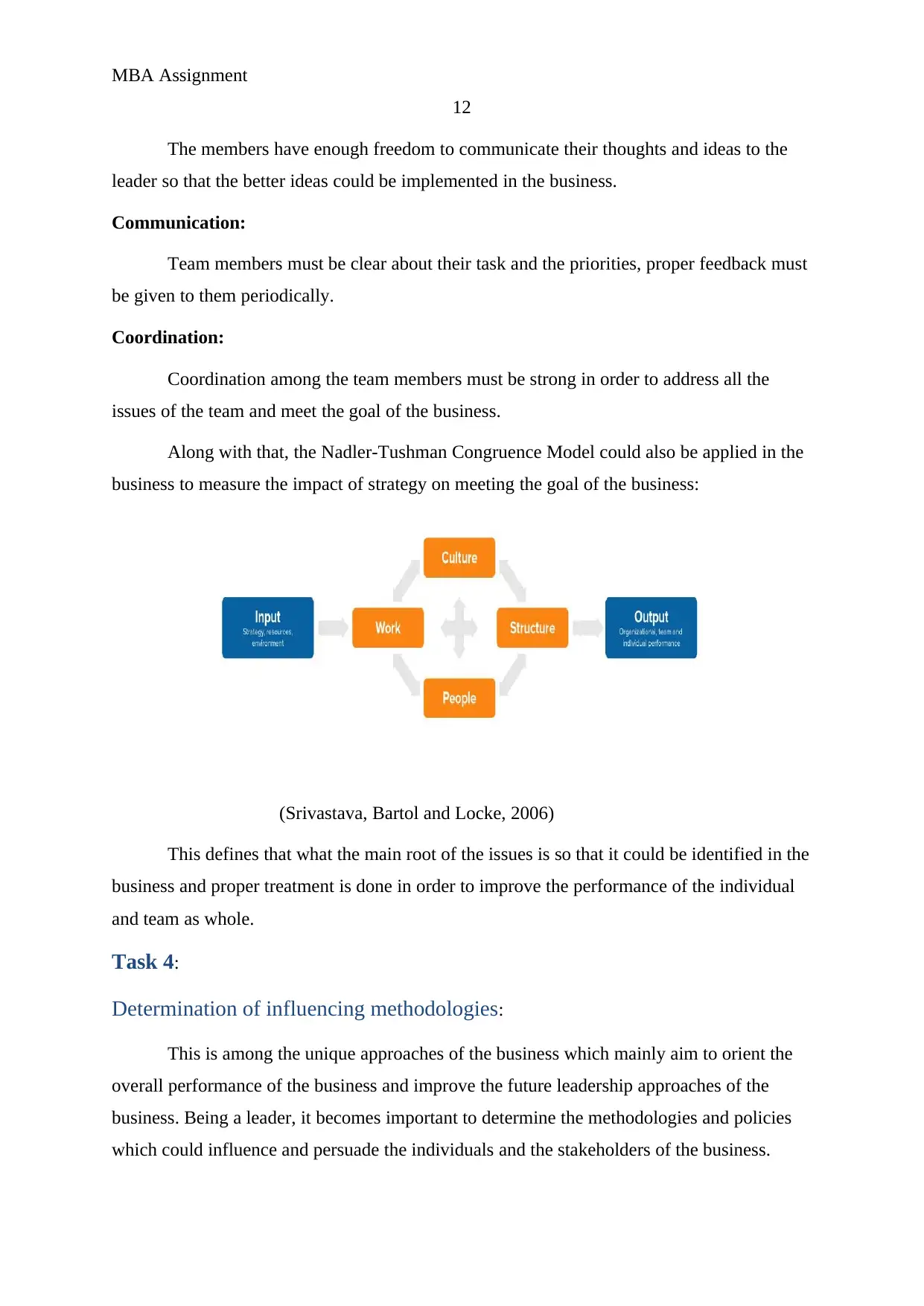
MBA Assignment
12
The members have enough freedom to communicate their thoughts and ideas to the
leader so that the better ideas could be implemented in the business.
Communication:
Team members must be clear about their task and the priorities, proper feedback must
be given to them periodically.
Coordination:
Coordination among the team members must be strong in order to address all the
issues of the team and meet the goal of the business.
Along with that, the Nadler-Tushman Congruence Model could also be applied in the
business to measure the impact of strategy on meeting the goal of the business:
(Srivastava, Bartol and Locke, 2006)
This defines that what the main root of the issues is so that it could be identified in the
business and proper treatment is done in order to improve the performance of the individual
and team as whole.
Task 4:
Determination of influencing methodologies:
This is among the unique approaches of the business which mainly aim to orient the
overall performance of the business and improve the future leadership approaches of the
business. Being a leader, it becomes important to determine the methodologies and policies
which could influence and persuade the individuals and the stakeholders of the business.
12
The members have enough freedom to communicate their thoughts and ideas to the
leader so that the better ideas could be implemented in the business.
Communication:
Team members must be clear about their task and the priorities, proper feedback must
be given to them periodically.
Coordination:
Coordination among the team members must be strong in order to address all the
issues of the team and meet the goal of the business.
Along with that, the Nadler-Tushman Congruence Model could also be applied in the
business to measure the impact of strategy on meeting the goal of the business:
(Srivastava, Bartol and Locke, 2006)
This defines that what the main root of the issues is so that it could be identified in the
business and proper treatment is done in order to improve the performance of the individual
and team as whole.
Task 4:
Determination of influencing methodologies:
This is among the unique approaches of the business which mainly aim to orient the
overall performance of the business and improve the future leadership approaches of the
business. Being a leader, it becomes important to determine the methodologies and policies
which could influence and persuade the individuals and the stakeholders of the business.
⊘ This is a preview!⊘
Do you want full access?
Subscribe today to unlock all pages.

Trusted by 1+ million students worldwide
1 out of 17
Related Documents
Your All-in-One AI-Powered Toolkit for Academic Success.
+13062052269
info@desklib.com
Available 24*7 on WhatsApp / Email
![[object Object]](/_next/static/media/star-bottom.7253800d.svg)
Unlock your academic potential
Copyright © 2020–2025 A2Z Services. All Rights Reserved. Developed and managed by ZUCOL.




